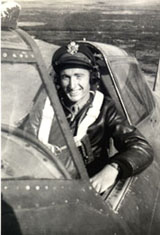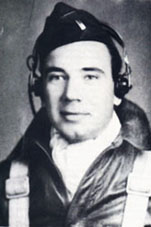Part 1:
On November 17, 1944, the 391st Fighter Squadron of the 366th Fighter Group flew what was perhaps our worst mission of the war. A major ground offensive had begun the day before along the Western Front from the northwest edge of the Hurtgen Forest up through Eschweiler, Germany. The weather was terrible with low-hanging clouds and light rain, but we were able to take off with each plane loaded with two 500 pound bombs and a 150 gallon belly tank. Sixteen planes from the 391st were involved in the mission.
When we reached the target area, we had to come in under the overcast at 4,500 feet. Everything was dark and eerie – we could see flashes of the big guns on the ground and the flak explosions in the air. Light from the exploding shells was reflecting off the clouds — it was as if we were looking into a segment of hell.
Dive bombing starting from such a low altitude is a challenge in itself, but each of us in turn did our best to hit our target. I was hit in the canopy right behind my head just as I rolled over to start my dive and was hit again as I pulled out of my dive. It was apparent I was in deep trouble as I fought to keep my plane in the air. In the meantime, the other 391st pilots were fighting for their lives. Lt. Rufus Barkley dived to strafe a German vehicle, and flew into the ground and exploded. Two of my tent mates, Lt. Richard “Red” Alderman and Lt. Gus Girlinghouse attacked a column of tanks and trucks along a road near a castle on the edge of the Hurtgen Forest, and both were shot down within seconds of each other.
My radio was out of commission, my controls were damaged, and the engine was barely generating enough power to keep me in the air. When I had crossed the front lines, I kept my eyes open looking for some clear space where I could belly in, if the engine gave out. By pure luck I came upon an American landing strip that was under construction, and was able to get my damaged bird down on the partially built runway. When I got back to my base several hours later, I was listed on the pilots’ board as “Missing In Action.”
The loss of my two tent mates was devastating. “Red” Alderman and I had gone through all our training together, and were very close friends. He had given me the farewell letters he had written to his wife and his mother – I was to mail them if he were killed. Lt. Gus Girlinghouse had just moved into our tent, so I was just getting to know him. The night of November 17, 1944, was the worst night of the war for me.


Part 2:
On December 16, 1944, heavily reinforced and upgraded German Armies attacked the American lines from the Ardennes, and the biggest battle of the war on the Western Front began, “The Battle of The Bulge.” The weather was so bad that most of our planes were grounded for about a week, and the Germans were able to advance about 40 miles into Belgium. On December 24th we were briefed for a mission and sitting in our planes waiting for the weather to improve, when our Operations Officer pulled up to my plane in a jeep. He told me orders had just come in for me to report to the Headquarters of the VII Corps, and that a staff car was coming to pick me up. Within a few hours I was on my way to this new assignment.
My new job was to coordinate all fighter-bomber attacks in front of the Divisions of the VII Corps. This was a major change for me; instead of doing my fighting from the air, I was now on the ground, and very near the front lines. Ground fire, such as artillery barrages, mortar fire, rifle and machine gun fire were now part of my life, instead of flak and the normal high risk of flying a fighter plane. As our armies advanced, pushing the Germans back, we moved our headquarters frequently to stay close to the front.
Around February 18, 1945, we moved into Merode Castle, about three or four miles from the town of Duren on the Roer River. The castle had been built in the Middle Ages. It was surrounded by a moat, and had several staircases leading up the circular towers to the ramparts, where archers in centuries past had defended the castle. Nothing about the area seemed particularly familiar to me, except that I knew I had flown several missions to attack German targets in this vicinity, especially during November. We were there now making preparations for a major attack to cross the Roer River, capture the town of Duren, and reach the open plains leading up to the Rhine River. The photograph below shows me in front of the main entrance to the heavily damaged castle about two days before the battle was to began. When this photograph was taken, I had made no specific connection with the events of our combat mission flown by the 391st Fighter Squadron on November 17, 1944.

Then in 1995, Robert V. Brulle, who was also a member of the 366th Fighter Group, wrote a story describing the terrible mission we flew on November 17, 1944. It was published in “World War II” magazine and included vital new information that Bob had secured from German sources, some of it from a German officer who had been involved in the battle that day, and actually commanded the flak guns that shot down Lt. Alderman and Lt. Girlinghouse. He had seen their planes crash, and was able to mark the exact location of impact. Before he moved his men and their flak guns out of the area, he ordered other German soldiers who were at the site of the crashes to bury the American pilots.
It is difficult to conceive that the machinations of war had placed me at Merode Castle three months after that terrible mission, and that my good friend, Lt. “Red” Alderman, was buried about 100 yards in front of where I am standing in the photograph above! It is equally unbelievable that one of the German guns that shot him down was firing from the drawbridge of the castle shown behind me in the photograph. Had I known at the time that he was buried there, and that my other tent mate, Lt. Girlinghouse, was buried about 800 yards farther out in the fields, it would have torn me apart. And to think that this information was not known by me until 50 years after these events took place.
Epilogue
Even though the German soldiers had buried Lt. Alderman at the site of his crashed plane, his body was never recovered. About ten days after he was buried a tank battle took place on the same ground, and all markings of a grave site were destroyed. His name is listed on the “Wall of The Missing” at the Netherlands American Cemetery near Maastricht, Holland. I visited this cemetery a few years ago, and touched the place on the wall where his name is engraved.
Several times over the years since the war ended, I had tried to locate “Red” Alderman’s children, but without success. When he was killed, his daughter, Lynn, was 15 months old. Then three weeks after his death, his second daughter was born, Cecilia Ann. I thought they would like to know something about their father — what a fine man he was, and what an excellent fighter pilot he was. I had no luck in my search until the film I wrote and produced, “A Fighter Pilot’s Story,” was shown in the area where they live near Seattle. Since then I have communicated with them, and have met and had an extensive personal visit with Cecilia Ann. I have been able to fill in some of the blank spaces, and help the Alderman girls know more about their father.
